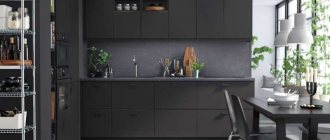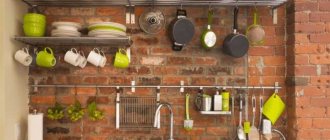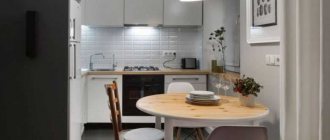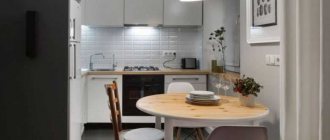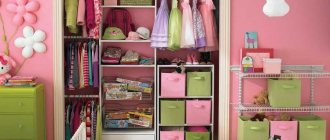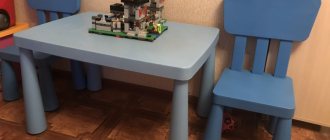Kitchen layout options
Rails can be placed in three ways:
- Horizontal. A classic look for a functional home railing system, where the pipe is attached between the countertop and the upper kitchen cabinets. Hooks, baskets, shelves and other accessories are hung on it. To easily make the most of your space, arrange your kitchen rails in several rows on an empty wall.
- Vertical. The pipe is installed vertically from the tabletop to the ceiling, and shelves and baskets are attached to it at a distance from each other. Most often used for bar counters and peninsulas. But such a design will fit no less perfectly into the free corner of an English kitchen set.
- Suspension. Based on the name, you guess that the railing system hangs from fasteners, from the ceiling. It looks most impressive above the island - suitable for organizing the storage of pans and cutting boards. Or above the bar counter - for glasses, shot glasses and even bottles.
Hanging models in the kitchen
This mounting method is optimal for island areas in the kitchen. The structure is suspended directly above the desktop.
The frame has a non-standard shape - in the form of a square, the inside of which is lined with decorative grilles.
Fastening devices are represented by chains or metal cables, which increase the reliability of the suspension.
What types of roof rails and hanging accessories are there?
The railing system includes the following basic elements:
- The roof rails themselves are most often in the form of a pipe with a diameter of 16 mm at the end or in the form of a flat strip. The length of one rod/bar can be 40, 60 (see photo below), 80, 100, 120 cm or 3 m.
- Wall holders - most often they are sold complete with a rod and screws, their number depends on the length of the railing. The holders can be standard or end-mounted (for fastening the crossbar between two walls).
- Caps - installed at the ends of the rails to make them look nice and be closed on both sides.
- Corner adapters (if necessary) - are used to combine two adjacent rails, while couplings are inserted into them at the junction points, then the joints are closed with holders. Of course, it is not at all necessary to connect adjacent rods; they can simply be closed with plugs.
- Coupling (if necessary) - is inserted into the holes of two pipes, then they are connected under pressure. A holder is always placed at the joint.
In addition to the basic elements, hanging accessories are a must - they must be selected based on individual needs.
- S-shaped hooks - they can be large or small, as well as double. You can hang on them not only ladles, colanders and potholders, but also any utensils, dishes, cutting boards, graters.
- Mini-shelves - you can put anything on them, for example, cans of bulk products, sauces, oil, etc. Shelves are small and large, regular and corner, single- or double-tiered, with or without additional holders.
- Baskets and glasses - designed for storing utensils, whisks, spatulas, and even for growing plants, such as herbs.
- Drainer .
- Drying rack for appliances.
- A towel holder - for example, may have a crossbar and several hooks.
- Paper towel holder.
- Holder for lids from pots and pans.
- Knife holder.
- Board holder.
- Holder for tablet or cookbook.
- Hot stand.
- A shelf for spices – as a rule, it is narrow and can be two-level. You can often purchase “original” spice jars for your shelf.
- Shelf for wine glasses.
- Bottle shelf.
- Holder for mugs and glasses.
- Breadbox.
- Holder for rolls: towels, foil, film, baking paper.
All these elements can be combined in one design, for example, a bottle holder with a glass holder or, say, a board holder with a knife organizer.
Rails and their advantages
Railings are a convenient and simple design in the form of a pipe, which is most often mounted under wall cabinets or along the edge of the tabletop. On it, kitchen accessories, towels, potholders, spoons, dryers, containers for storing spices and other utensils are placed on hooks and hangers.
Railing in the kitchen increases the functionality of the workspace, allowing you to get rid of some of the bulky cabinets. The kitchen begins to look spacious and cozy.
Externally, the roof rails resemble a cornice, consisting of a main element - a tube and fasteners. A huge number of all kinds of accessories are produced for roof rails - shelves, hooks, holders, etc. The tube is covered on both sides with plugs, giving it an aesthetic appearance.
The peculiarity of the system is that it can be matched to any interior and any size of the kitchen. For a small kitchen, roof rails are the solution to many problems. One of the important advantages of the railing system is its mobility. Accessories can be swapped and moved at any convenient time.
In addition to the above, the advantages of roof rails include:
- placement anywhere;
- the presence of numerous additional accessories;
- favorable price;
- ease of installation;
- strength;
- ability to withstand heavy loads.
What can you hang on the railing?
A pipe on the wall alone will not add functionality to your loft kitchen. The most important thing is the hanging modules, which are selected and placed depending on everyone’s personal preferences.
Let's look at the main pendant options:
- Hook . The simplest and most cost-effective, yet effective filling. You can hang various ladles, spatulas, towels, potholders, frying pans, stewpans and much more on them.
- Shelf . Depending on the size and depth, they store everything from detergents and sponges to jars of sauces and seasonings.
- Basket . The high edges make it safer than a shelf and better suited for tall bottles and cans.
- Cup . Not all kitchen utensils have holes and hooks, having a glass will solve this problem - just put cutlery, spatulas and other things in it.
Dryer. They are used both for temporary arrangement of dishes after washing, and for permanent storage of the main set of plates and mugs.
Holder. Special designs are developed for:
- paper towels;
- foil, baking paper and film;
- pots and pans;
- covers;
- cookbooks and tablets;
- cutting boards;
- knives;
- mugs and glasses;
- small household appliances.
- Magnet. Usually used for storing knives, but you can place anything: iron jars for spices, flowerpots and containers.
- Jar. Suitable for horizontal railing system. Thanks to the hook-shaped lid, it fits directly on the tube without additional shelves. Because The jars are small and spices are usually poured into them.
Horizontal mounting of the model
The central pipe is attached parallel to the working surface:
- On the wall.
- On the side surface of the kitchen unit.
- In niches and openings of wall panels.
Fastening is carried out at two or three points, depending on the length of the central axis.
How to create a railing system for yourself?
When installing roof rails, the rule “more is better” does not work. Therefore, you should not buy all possible accessories for the railing system and try to find a use for them. You can also contact specialists.
It would be original to go from the opposite: watch your behavior while preparing and eating food, as well as cleaning. What items and products do you use most often? Ideally, attach to the railing something that a person uses every 1-5 days.
To test the theory, you will have to make a model of the future structure directly on the wall using masking tape. This way you will understand whether you have enough space and what is missing. Just be careful not to damage the wallpaper.
The equipment also depends on your kitchen:
- In small rooms, for convenience, store only the essentials on the railing; a lot of items will create a feeling of chaos.
- In a spacious kitchen, install a long pipe, stylishly arranging accessories at a distance from each other.
- In a set with a country corner sink, dish soap and a sponge are placed on a hanging shelf.
- In a kitchen with a free surface in the corner there is a place for a vertical matte rail.
How to attach
According to the method of fastening, railing systems are divided into:
- Horizontal. The most common option and the most functional.
- Vertical. It has a vertical axis with side hooks and is located in the corner, on bar counters to save space.
- For large rooms, the hanging method is used, where the railing system is combined with wide shelves and stands. They are installed on chains, cables, ropes to the ceiling in the work area. These can be island structures or attached to panels.
- The rails on suction cups are mobile, they can be easily installed and moved as needed. A clear disadvantage will be the small carrying capacity.
A few more life hacks
If there is not much space in the kitchen, you should not spend money on a separate holder for lids, because they can be conveniently stored. Examples in the photo below.
- To save space on the kitchen rail, appliances and kitchen utensils can be placed in one hanging glass instead of hanging on hooks and cabinets separately from each other.
- Store kitchen utensils, food, dishes and textiles on rails strictly according to categories. We often forget this simple and obvious rule, but meanwhile, its observance guarantees you orderly care in the kitchen. For example, it is more convenient to place paper towels next to kitchen towels and oven mitts, because they perform approximately the same function.
- If you choose cutlery, dishes, potholders and other “wall” items in the same color scheme, you can avoid the feeling of disorder and diversity. This advice is more relevant for those who are arranging their kitchen from scratch. Here are some photo examples of such wall storage.
Model range of devices
In the photo of kitchen rails you can clearly see what the equipment is. Evaluate practicality and choose your favorite version of roof rails for the kitchen in Leroy Marlin.
Accessories
Properly selected accessories improve the functionality of roof rails, expanding the number of items that can be placed on them.
Hooks are the basis of all railing systems with a headset. Shelves, nets, containers, and holders are hung on them. They often act as an independent element of the system. Ladles, skimmers, mugs, scissors, etc. are hung on them. Some housewives even hang frying pans and saucepans on hooks so that everything is at hand.
Shelves are available in a wide variety:
- They are great for storing a variety of things. They are convenient for arranging jars and containers for spices instead of other containers. On shelves with long hangers, you can install tall and long cans and bottles, observing the placement conditions. They even sell a slanted shelf to hold a cookbook with an open recipe on it, which would be convenient to hang above the work area.
- In mesh shelves located near the sink, detergents and cleaning products, fruits that drain after washing, etc. will find their place. Mesh shelves are sold in a variety of configurations: rectangular, square, sector-shaped, round, oval, etc. Mesh shelves are also good for storing spatulas and a slotted spoon near the stove. This is where the stirring and turning process takes place.
- The holders may contain whisks and spatulas, paper towels and food foil (coating). There are holders for wine glasses, glasses, bottles, cups and other utensils. For paper towels, you can purchase a towel holder with a serrated edge to make them easier to tear off. The place for such an accessory is near the sink.
- In addition, you can list such accessories as hanging systems for storing spices, wall-mounted bread bins, baskets, glasses for kitchen utensils, dryers, and soap dishes. The systems can be supplemented with magnetic elements, convenient for storing knives.
Railings are a great way to decorate the interior of a part of the kitchen with beautiful dishes and other decorative accessories. They can be used as a support to create additional lighting for the work area by placing small directional LED contact lamps on them.
Accessories: versatility and functionality
Kitchen apron rods cannot be considered without accessories for them:
- dryers for dishes, cutlery and glass;
- all kinds of cups;
- jars with lids;
- holders for glasses, glasses, cups;
- baskets;
- bread bins;
- hooks of various types and configurations;
- mesh shelves;
- universal shelves;
- shelves with glass for kitchen utensils;
- shelves for spices;
- shelves for spices with jars;
- holders for paper towels, foil, paper, cling film;
- kitchen towel holder;
- holders for knives, lids, cutting boards.
Shelves with mesh bottoms of various designs and purposes have special functionality. The mesh bottom does not allow liquids to linger and therefore they are simple and easy to clean compared to closed shelves.
It would be appropriate to place a dish draining rack next to the kitchen sink
Shelves can be used depending on the area in which they are located.
Round shelves are usually used in the washing area to store dishes, cutlery, and food after washing. And also for storing washcloths, sponges, detergents. It is rational to place towel holders in this area.
Place the items you use when washing dishes above the kitchen sink.
In the cooking area, multi-level shelves for spices, seasonings, and napkins are most often used. Holders for knives and cutting boards are required here. The same shelves can be placed in the tea and coffee brewing area, placing jars of tea, coffee, herbs and brewing accessories on them.
In the hob area it is worth placing cooking utensils (spatulas, ladle, tongs), oven mitts, shelves with spices.
There is no need to hang all kitchen utensils on rails; store on the wall only those items that you are used to keeping on work surfaces
If the structure is able to withstand heavy loads, you can place small household appliances on the shelf: toaster, mixer.
If the kitchen is small, it is recommended not to overload it with hanging elements; a few hooks and shelves will be enough.
Railing shelves allow you to use wall space as efficiently as possible
A corner kitchen provides the greatest opportunity for distributing shelves and hooks. On a short wall it is better to place a multi-level railing system with shelves and hanging elements.
Kitchen rails are a storage system and provide convenience and comfort in the kitchen, which is their main advantage. The types of railing systems are varied and are a necessary attribute in a modern kitchen. They are made from high quality materials and come in a wide range of colors. Can be selected to suit any kitchen interior. The variety of hanging elements and accessories provides endless possibilities for their variations.
What color are the roof rails?
Rails are made of metal (stainless steel, aluminum, brass), polymers and wood. Stainless steel rails are the most common due to their practicality and affordability. For the kitchen, you can choose roof rails in different colors: chrome-plated, white, gold-plated, copper-plated, bronze-plated, black nickel-plated. We offer plugs and other fittings to match the color of the roof rails for repair.
Here it would be appropriate to talk about the load-bearing capacity of the devices, which must be taken into account when choosing a roof rail. An anodized aluminum product is not suitable for use over a large area. Aluminum railing can only be done in small sections. Of course, stainless steel has the greatest strength.
When choosing the color of the railing system, you need to focus on the purpose and style of the kitchen interior and the color of kitchen appliances (stoves and hoods), as well as furniture handles.
Why should you choose roof rails for the kitchen?
Installed crossbars in the kitchen are always a highlight of the interior. With this unusual element, the Chefs guaranteed themselves maximum functionality of the work area and quick access to constantly used materials. Later, this idea moved to bars, and then to home kitchens.
Buying a roof rail system for the kitchen is no longer difficult for anyone, because the cost of the product is affordable for every family.
Products are made of metal:
- Aluminum;
- Nickel;
- Brass;
- Made from stainless steel.
Poti, each product has a decorative chrome coating. The plugs for them are matched to the color of the crossbar.
Advantages of using a railing system in the kitchen (pros and cons)
- All types of kitchen rails came to our homes from restaurants. Thanks to them, you can easily create a work area for cooking and free up “chaos” in the drawers;
- All frequently used items are at hand and at the same time do not take up free space in the work area;
- The products are made of anti-corrosion steel. Accordingly, humidity, certain chemical reactions and mechanical stress will not affect the final design;
- This mechanism can withstand severe mechanical stress, while retaining its original appearance and shape;
- Mobility. That is, installation of such a decorative element is possible anywhere. At the same time, it is possible to move the mounts wherever you want;
- There is no need for specific care. Only occasionally you need to wipe off dust and remove stains;
- Wide range of choice (stores offer a lot of different models, among which you will clearly find what you need).
Materials
Railings are also differentiated based on the materials chosen for manufacturing and installation. Manufacturers offer to assemble hanging systems from wood, stainless steel, nickel, brass and aluminum. Most of them are chromed bathroom. You can choose various options: drawers, furniture, dowels for your kitchen, based on its style and general design concept.
To make the rails look harmonious, they are also sprayed to match the color of copper, bronze, gold and other popular colors of ladles. They not only allow you to choose the plank to match your kitchen design, but also create an additional layer of protection against corrosion and moisture.
Speaking about the variability of materials, their pros and cons, it is necessary to note the advantages of the load that they can withstand.
This is a very important aspect for kitchen storage. Metal is practical and durable, but if you choose an aluminum rail, you shouldn’t load it too much with heavy utensils or make it too long. Stainless steel is considered to be the most practical material for roof rails, since it is quite durable and not susceptible to rust and is suitable for any finish.
Placement of roof rails
- When deciding on the location of the rails, consider the overall configuration of the kitchen and the backsplash. Often, horizontal slats are placed above the kitchen work area.
- Regardless of the surface on which the planks are attached, install them at a height of 30 to 50 cm from the countertop. This is the most convenient and practical height.
- If you decide to place the crossbar under the hanging cabinet, then step back 5–10 cm from its bottom. Thus, the cabinet will not interfere with access to kitchen utensils placed on the crossbar.
- In some cases, it will be more logical to place the storage system on the sides of the cabinet. For kitchens with a corner configuration, rails curved at right angles are offered.
If your kitchen has an island configuration, then placing storage above the island or counter is the right solution.
It’s good if the area of the room allows you to “play” with the location and geometry of the roof rails. By placing them at different heights, you will get an attractive and non-trivial decorative element. This way you can also perfectly zone your storage space.
We have prepared some more tips for those who are planning to install rods:
1. Install roof rails in the most convenient and accessible places. This way you will not feel inconvenienced while cooking, the whole process will become more comfortable and optimized.
2. Based on the general concept of your kitchen, you can place several small planks near the work area or install one long structure with a corner bend.
3. Don't forget about safety in the kitchen. This is especially true for ceiling structures. Fasten them as firmly and securely as possible, this way you will protect yourself from injury.
4. The basic rule for designing roof rails: the items you use most often should be closer to the work area, and vice versa. Place jars of spices, oven mitts and matches or a lighter next to the tile. It is appropriate to place a towel and a shelf with detergents above the sink.
If you use cling film or paper towels, buy holders with jagged edges to make them easier to tear off.
5. To prevent ladles or spoons from getting dirty with grease, do not hang them over the stove.
6. You can adapt the slanted shelf as a kitchen book holder. This will make the cooking process even simpler and more fun.
Thoughtful and well-designed roof rails reduce the housewife's efforts to a minimum, and the entire cooking process becomes very fast and extremely enjoyable.
Where is the place for roof rails for the kitchen?
“The most practical and spacious are the corner shapes of the roof rails for the kitchen, which can be installed in the sink area.”
The layout of the roof rails in the kitchen space will certainly be affected by the configuration of the room. In the standard version, the system is installed in the work area. The crossbars can be attached to any surface: painted, covered with wallpaper or laid with ceramic tiles, the main thing is to maintain the correct height. Railings are placed no lower than 40 and no higher than 50 centimeters from the tabletop. If the system is installed in the space between the countertop and the bottom of the wall cabinet, then make sure that the rod is not closer to the latter by more than 8-10 cm. To be able to properly load the structure, the rod holders should be located every 50 cm.
Rails can be attached to any surface in the kitchen
Sometimes roof rails are installed directly on the side walls of kitchen cabinets. For kitchens with a corner configuration, there are railing structures that are identical in shape.
Corner railing for the kitchen
If desired, compact horizontal crossbars can be secured above the stove. On such an improvised shelf it will be convenient to arrange your favorite spices, hang a slotted spoon and other utensils used in the cooking process. Such roof rails can decorate the end of the tabletop or the side surface of the kitchen island. If you need to make the storage system secretive, then rods with hooks and shelves are placed on the inner doors of cabinets and cabinets.
Railing on the side surface of the cabinet
It’s good when the kitchen walls are not cluttered with furniture. In this case, there is a chance to play with geometry. You can try to place the holders at different heights or secure them, for example, with broken lines. This way you can not only categorize objects according to their purpose, but also get an original decorative element
Combined roof railing for the kitchen
Vertical railings also often appear in the work area of the kitchen, but they look most original in the relaxation area. Shelves are most often hung on the supporting tube, and hooks are less common. How many tiers there will be in your system - decide for yourself. If necessary, the design of the structure can always be adjusted by changing the height of the shelves, adding or reducing their number.
Vertical railing in the kitchen dining area
The presence of such an element will allow you to relieve the surface of the tabletop as much as possible. By removing all the small utensils from it, you will finally not be constrained in your actions and will be able to cook with greater comfort. The most practical and spacious are the corner shapes of roof rails for the kitchen, which can be installed in the sink area.
Convenient corner railing in the sink area
Vertical rails allow you to use the kitchen space even more ergonomically and experiment with its design. For example, a support rod can be placed at the entire height of the kitchen, rather than resting it on the countertop.
Functional full-height kitchen railing
It will accommodate many more shelves of different shapes and volumes, which can be made of:
1. Plastic.
2. Trees.
3. Glass.
4. Metal.
Often, kitchen rails are equipped with holders for glasses, glasses and glasses, stands for bottles and baskets for fruits. Sometimes they are given an unusual mission, making them the supporting leg of a bar counter, or mini-tables on which breakfast is served.
Vertical railing with fruit basket
In island kitchens, railing systems are suspended above the dining area.
Ceiling rail for kitchen island area
Choosing a roof rail to suit your kitchen style
Despite all the usefulness of roof rails, it cannot be said that they are suitable for any style. Japanese card style or minimalism eliminates unnecessary details, so this storage system is rather inappropriate.
In other styles, for example, Californian or Italian, metal strips will look quite harmonious, especially in combination with other characteristic decorations. Rustic styles also advocate the use of rails for storing dishes and kitchen accessories. For a traditional or retro style, planks finished in bronze or gold are suitable.
- high-tech style can be diluted with thin metal strips. The main thing is not to overload the interior with an abundance of roof rails.
- rustic- kitchen can be decorated with wooden rails on which various spoons, potholders or small jars for spices will be placed.
Use your imagination, study the chosen kitchen style and you can easily play with the roof rails.
How to choose a roof rail for your kitchen interior?
For a kitchen that is decorated in a minimalist style, you should not use pipes. The fact is that the laws of minimalism dictate that only a minimum of elements can be used. Towels, spices, as well as kitchen utensils - all this will be conveniently placed on the crossbar, but they are definitely not suitable for strict minimalist kitchens. In interior design, where there is room for charming little things, railing will definitely be in place. It looks great in the interior of Mediterranean and Italian cuisine, and will also fit stylishly into country and Provence. For retro and classic style, roof rails in gold and bronze are suitable.
Wooden accessories in a classic kitchen interior are chosen in unison with the color palette of kitchen furniture. In modern kitchens decorated in hi-tech style, chrome elements will look good.
For a fashionable and modern loft, industrial and steampunk, you can take systems that are assembled in the style of water pipes. For the production of a certain style, it is extremely important what exactly hangs on the railing. Box jars and checkered textiles are suitable for shabby chic style. Mini pots with fragrant herbs, large glass jars for storing coffee and tea will complement the Provence style. Pepper and salt mills made of wood and mortars made of copper will complement the retro design. As for a simple urban interior, you should not overload the roof rails. Several large and small elements will be enough, for example, near the stove, you can put a set for oil, spices and vinegar, closer to the place of eating - a hanging shelf with jars and cups for tea, and a mixer near the work area.
Tips for choosing
Experienced kitchen interior designers share several rules that will help you choose and install roof rails:
- It is necessary to make maximum use of space planning opportunities. To do this, you need to carefully consider the number of hooks, shelves, holders and other elements.
- When choosing and placing accessories, it will be correct to take into account its purpose. For example, spice jars would be best placed next to the stove, while a basket with a sponge would be best placed by the sink.
- The fastening must be as strong and reliable as possible, since over time the pipes may begin to sag and put additional pressure on the fastening elements. In the worst case, the railing system may collapse, which is completely unsafe.
- On the one hand, it would be logical to place ladles, ladle and skimmers on hooks next to the stove. But this way they will be constantly splashed with drops of fat, so it is better to hang them near the work area.
- When thinking about what to hang on the railing, you should focus only on the most frequently used items such as a ladle, a sponge for washing dishes, a towel, a container for oil or spices. You should not oversaturate the space, as this is not practical, as it might seem at first glance.
If frying pans will hang on the rails, they must be in perfect condition not only from the inside, but also from the outside. If greasy drops or traces of burning are visible on the bottom, then this does not paint either the kitchen or the housewife.
Among the variety of roof railing accessories, it is worth paying attention not only to beauty and functionality, but also to the quality of the product. Since the climate in the kitchen is difficult, a low-quality product will quickly lose its presentable appearance and may even become deformed. European parts from Germany, Italy, France, the Czech Republic, and Holland are most valued.
The main rule for choosing the location of the railing is that the owner must reach it without taking extra steps.
The most frequently used items should be placed closer to you. Things that are rarely used are either removed altogether or moved further away.
Most often, 1-3 small rails will be enough. Even in a fairly spacious kitchen of 12 square meters. It’s better not to use more than three 60-centimeter rods, so as not to visually clutter or overload the space.
Metal rails should be combined with the rest of the fittings in the kitchen.
Installation of roof rails in the kitchen
Kitchen rails and hanging accessories for the kitchen are traditionally placed near the work area or near the apron so that the housewife can conveniently reach the necessary utensils when working in the kitchen. You shouldn’t limit yourself to just one roof rail – let’s consider a couple of options. For example, one of the longest elements (from 1 to 1.5 meters) can be hung above the work area, and the shortest one near the sink and stove. In some interior designs, it will be interesting to look at another fastening of horizontal pipes on the sides of the cabinets. For corner places it is worth purchasing a system that is bent at an angle of 90 degrees.
If you place the crossbars at different heights, you will get not just a placement of objects, but also a beautiful decorative element. But the crossbar should be placed from the tabletop at a height of 0.4 to 0.5 meters. When placing rails under cabinets, the best distance from them is considered to be 8-9 cm. In island-type kitchens, hanging systems are often placed above the dining table. When placing other accessories, try to keep all the items you use most often as close to the work area as possible. For example, it would be appropriate to place shelves for pepper and salt, oven mitts and lighters near the stove. Ladles, spoons, and skimmers should be kept away from the stove so that they are not stained with grease.
Installing a roof rail - it all starts with markings. Mark the starting point, the end point and a few intermediate points if the length of the railing is large. We strongly recommend that you install the railing holders at a distance of 0.5 meters. For the most accurate marking, it is most convenient to use a laser level at the points and drill holes with a diameter of 0.6 to 0.8 cm to fix the supports for the holders. If part of the railing gets on the apron, then the holes need to be drilled using special glass on the tiles.
Next, insert the dowels into them and attach the support pins for the holders with self-tapping screws. Assemble the railing system according to the instructions - secure the plugs, and then thread the holders onto the pipe. There should be the same distance from the plugs to the side holders. If necessary, you can shorten it with a simple hacksaw. Next, insert the system with holders onto the supports. Tighten the bushings that are secured to the support with a hex wrench until they stop. The holders should be placed so that the fixation screws are at the bottom.
There is another assembly option. You should immediately put holders on the supports, through which the railing pipe will be pulled. The holders should be secured to the pipe. At the end, plugs are inserted in the air. Decide for yourself how easier it is to assemble. If the system goes through a corner, you will have to assemble additional corner connections. They represent an arc of 135 or 90 degrees. They will be held without fastenings, connecting straight rails to each other. There are railing systems that are installed in the solution. The design of these systems includes another stand, which extends to the required length for fixation. Instead of plugs, these systems have linings made of durable silicone or plastic, which will prevent damage to the surface of the support. As a result, the high-strength railing design will only make them popular. This is the best solution for any kitchen - both small and spacious. They will decorate many modern interiors.
The best manufacturers and their features
The variety of roof rails on the market lies not only in shapes and sizes, but also in different manufacturers. Many of them, due to the simplicity of the system, have a good reputation and positive reviews from site consumers. Let's look at the most popular ones.
IKEA
The Swedish company was one of the first to promote the idea of roof rails on the Russian market. Now she has a huge assortment that allows her to make any desire come true. One of the latest innovations is a special system on rails for growing indoor plants - this is a non-standard application.
Leroy Merlin
Leroy Merlin, under its own brand Delinia, produces fairly high-quality products that are budget-friendly. The feature is the same - a huge variety of goods. Including on the floor.
Lemi
As a true Italian brand, Lemi focuses on the perfect design of details. Accessories can be chosen in any style and color, there is even a special “black velvet” coating. Of course, the quality is also high.
Lemax
The enormous popularity of this brand is ensured by its budget price and good quality parts. It is made in China, but lasts a long time and collects positive customer reviews.
Kessebohmer
A German brand for which functionality and practicality come first. You can find absolutely different models - even in the form of carousels. Characterized by typical German quality.
Tescoma
A well-known Czech brand of tableware that has proven itself well on the Russian market. The manufacturer has no doubt about the quality of its products, therefore it provides a guarantee of 5 years.
Starax
Turkish brand founded in 1996. Popular not only in Europe, but also in Asia. It produces roof rails not only from stainless steel, but also from other materials. Huge range of models.
Hettich
Another German brand. It has a high price tag, but this fact is compensated by the excellent quality of the product. In addition to reliability and durability, roof rails are also distinguished by their aesthetic beauty.
